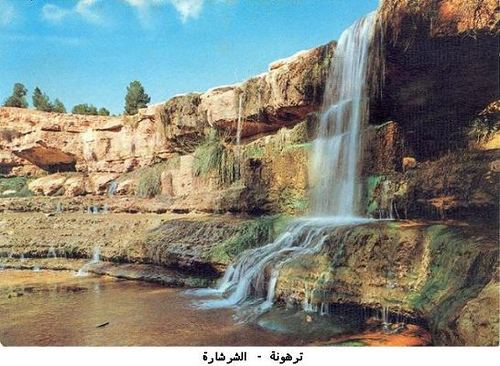Elevation 393 m Local time Monday 2:51 AM | Time zone EET (UTC+2) Population 13,264 (2011) | |
 | ||
Weather 14°C, Wind NW at 6 km/h, 91% Humidity | ||
Tarhuna (/tɑːrˈhuːnə/; Arabic: ترهونة), also Tarhoona or Tarhunah, is a Libyan town 65 kilometres (40 mi) to the southeast of Tripoli, in the Murqub District. The city derives its name from that of its pre-Roman-era inhabitants, a Berber tribe. The city was known as al-Boirat during the 19th through mid 20th century, but assumed it current name after Libyan independence. The Tarhuna district, including the city of Msallata, had an urban population of about 296,000 (est. 2003) Geographical boundaries: from the "Valley of the famm Molgha" west - to "Burkaat Oueny" eastward. Then from the "Suq al Juma (Al-msab`ha)" north, " Al-mzawgha and Marghna" south, while population in Tarhuna proper was calculated to be 13,264 in 2011.
Contents
Map of Tarhunah, Libya
History
In the city centre of Tarhuna, just opposite the Tarhuna mosque, there is a memorial to Ali Swidan Alhatmy, who was a hero in the 18 June 1915 Battle of El-Shqiga against the Italians. He was captured in 1922 and hanged by the Italians in the town square.
Population generally belongs to the Tarhuna tribe, which was favoured during the regime of Muammar Gaddafi. In late August 2011 (as part of the Libyan Civil War), opposition forces from the National Liberation Amy entered Tarhuna, amidst mixed feelings from the citizens. It is known that Khamis Gaddafi, son of Muammar Gaddafi, died in clashes near Tarhuna.
On 23 August 2012 Interior ministry spokesman Abdelmonem al-Hur stated that more than a hundred tanks and twenty-six rocket launchers were seized from an alleged pro-Gaddafi militia (named Katibat Al-Awfiyah, or Brigade of the Faithful), during a raid on their campsite in Tarhuna. The operation ended with one of the suspects killed, eight wounded and thirteen detainees, accused of being linked with the 19 August Tripoli bombings.
Economy
Tarhuna is a leading producer of olive oil, cereals, figs, grapes, sparto grass, and various nuts.
Education
The Faculty of Law of Al Nasser University is located north of town.
Notable people of Tarhuna
Sport
Founded in Tarhunah many sports clubs: Al-Noor School club ( teachers club ) - Al-Amal Club was founded in 1960 - the hero of the Football League in the central region - currently playing in the third division Al-Shabeba Club Club Soqor Al-Sag`ya
